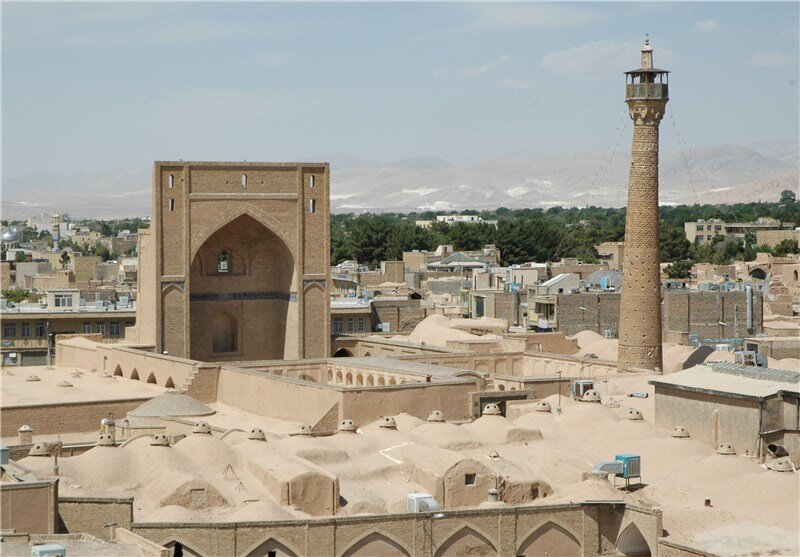Tranquility amidst history: Jameh Mosque welcomes travelers to Semnan

TEHRAN - In the heart of the ancient city of Semnan, where the whispers of the Silk Road still echo through time, lies a jewel of Islamic architecture, a testament to centuries of cultural exchange and spiritual devotion.
Jameh Mosque of Semnan is an enchanting destination that offers travelers to discover one of Iran’s earlier mosques.
As the sun begins its ascent over the rugged horizon, casting a golden glow upon the labyrinthine alleys of the ancient bazaar, visitors find themselves drawn toward the grandeur of the Jameh Mosque.
Stepping through the centuries-old archways, they are transported back in time to an era of empires and dynasties, where faith and artistry intertwine to create architectural marvels that stand the test of time.
At the heart of the mosque lies a tranquil courtyard, surrounded by intricate colonnades and adorned with delicate stucco work. Here, amidst the gentle rustle of long-lived trees and the soft murmur of prayer, travelers pause to admire the architectural splendor that surrounds them. Each corner of the courtyard tells a story, from the graceful curves of the qibla iwan to the towering minaret that reaches towards the heavens.
The qibla iwan, a majestic gateway adorned with ornate brickwork and vibrant tile mosaics, serves as the focal point of the mosque. Constructed in the 15th century during the Timurid period, its towering arches beckon worshippers to enter and seek solace in the sacred space beyond. As the sunlight filters through stained glass windows, casting a kaleidoscope of colors upon the tiled floor, visitors cannot help but feel a sense of awe at the beauty that surrounds them.
Venturing further into the mosque, travelers discover a treasure trove of architectural wonders, each bearing the mark of a different era in Semnan's storied history. From the graceful arches of the dome chamber to the intricate stucco decorations that adorn the vaulted ceilings, every detail speaks to the craftsmanship and dedication of the artisans who built this sacred sanctuary.
In the southeastern prayer hall, columns of brick rise like sentinels, supporting the weight of centuries with quiet strength. Here, amidst the flickering light of oil lamps and the scent of incense, worshippers gather to bow their heads in prayer, their voices mingling with the ancient echoes of generations past.
On the northeastern side of the courtyard, the minaret stands tall and proud, its tapering form reaching towards the boundless sky. Renovated during the Safavid period, it bears witness to the enduring legacy of Semnan's Islamic heritage, its geometric designs and Kufic scripts are a testament to the ingenuity of Persian craftsmanship.
As the day draws to a close and the call to prayer echoes through the narrow streets of the ancient city, travelers linger in the shadow of the Jameh Mosque, reluctant to leave behind the beauty and tranquility they have found within its walls. For here, amidst the timeless beauty of Islamic architecture, they have discovered a connection to the past, a glimpse into a world where faith and artistry intertwine to create something truly extraordinary.
Semnan, situated 216 kilometers east of Tehran, lies nestled in the southern foothills of the Alborz mountain range and to the north of the Kavir desert, marking a key point on the route from Tehran to Khorasan, boasting an elevation of 1130 meters above sea level. The city experiences an arid yet temperate climate.
Semnan offers a diverse landscape, encompassing vast deserts and rugged mountains, which contribute to its climatic variety. The local economy benefits from a thriving industry and mining sector, fostering the creation of high-quality handicrafts such as pottery, silk weaving, and rugs, which have played a significant role in the city's growth. With its natural wonders dating back thousands of years, Semnan has become a popular tourist destination.
Situated along historical invasion and migration routes between the East and West, Semnan is home to remnants of ancient civilizations, including historic areas, cisterns, and aqueducts, each boasting unique architectural styles spanning various eras.
Semnan has long been recognized as a center for religious and scientific scholarship, and it remains one of Iran's leading cities in terms of literacy initiatives, playing a pivotal role in reducing illiteracy rates across the country.
AFM
Leave a Comment